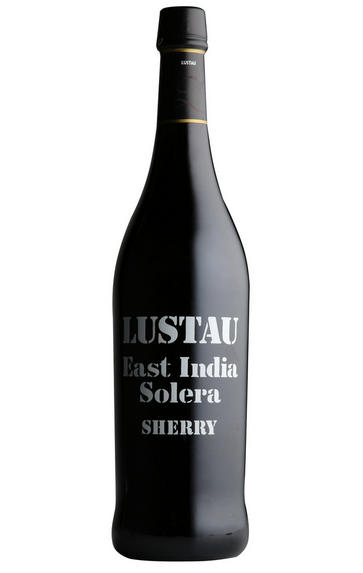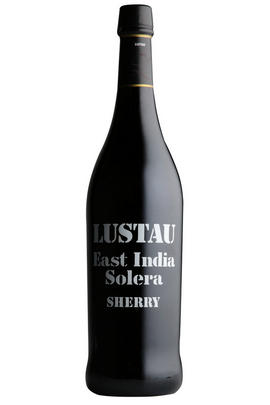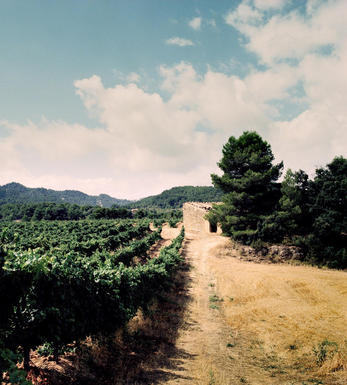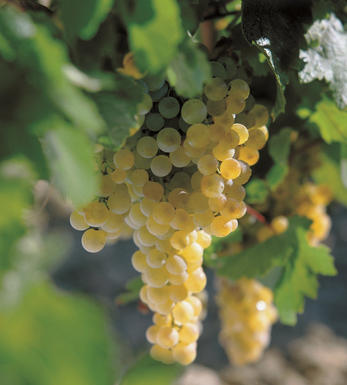
Bodegas Lustau, East India Solera, Jerez, Spain

Critics reviews
Wonderfully oddball rancio character, with toasted almond, fig, and a spray of citrus peel. Loads of flavour concentration, loads of sweet complexity on the length. Combines the mushroom, umami complexity that so often features in great mature wine with vigour and refreshment thanks to the sweet and tangy finish.
Drink anytime
Richard Hemming MW, JancisRobinson.com (August 2021)
The dark amber-hued non-vintage East India Solera is essentially an old Oloroso blended with an old Pedro Ximenez, which gives it a sweet character. It offers more mature notes of maple syrup, brown sugar, spice box, raisin and chocolate beer nuts, and its terrific balancing acidity cuts through the sweetness. This delicious effort is best drunk after the meal.
Robert M. Parker, Jr., Wine Advocate (August 2012)
Full of toffee and caramelized nuts, this sherry is rich and frankly sweet, but it has a lot of character. Rather subtle prune note at the long finish.
Drink now
James Suckling, JamesSuckling.com (October 2018)
About this WINE

Bodegas Emilio Lustau
Emilio Lustau was established in 1896 and was initially a small family concern until the founder`s son-in-law placed it on a business footing.
The firm is perhaps best known as pioneering the Almacenista system, whereby individual dry sherries are produced from small private holdings. These are bottled under Lustau`s name but with the individual bodega's name on the label as well. Today they are amongst the most sought-out Sherries in the region.
The firm also produces superb wines from its recently acquired 170 hectare Montenegrillo vineyard.

Oloroso
Oloroso Sherries, made from Palomino grapes, are by default dry, amber- to mahogany-coloured with pronounced nutty fragrance and flavours, full, vinous body and persistent finish. The alcohol content varies between 17º and 22º.
The sweet version is sweetened before bottling with luscious, sticky, treacle-thick wine made from Pedro-Ximenez grapes. Sweet Olorosos are really hedonistic, combining aromas and flavours of molasses, figs, prunes and melted toffee overlaid by sweet spices (cinnamon, cloves, liquorice) .
Olorosos are not allowed to grow the flor yeast during the maturation, so they lack the fresh yeasty/salty taste of the Fino and Amontillado sherries. Without the layer of flor, Olorosos undergo a more intense oxidative exposure that imparts the characteristic nutty flavours. Precisely because their long oxidative ageing, they are among the longest-lived wine styles. Sweet Olorosos are perfect companion to caramel and dried fruit desserts, cakes and blue cheeses.
Cream sherry, Amoroso, and Brown sherry are different styles (in terms of sugar content) of PX-sweetened Oloroso.

Palomino Fino
Palomino, named after Fernan Yanez Palomonio, one of King Alfonso X`s knights, is the primary grape variety for Sherry styles (Fino, Manzanilla, Amontillado, Oloroso, Palo Cortado) production.
It is a high yielding variety that is widely planted in Spain producing mostly insipid thin, dull wines lacking in fruit and acidity. However it thrives on the predominantly chalk based soils of Cadiz where it produces large bunches of golden yellow grapes, which ripen in early September. The resulting must is transparent in colour and somewhat neutral in flavour, but the subsequent wine can develop a coating of flor before maturing in the solera system and produce a whole range of intense and aromatic sherries.
It is also grown in South Africa, California, and Australia where it is fortified to make sherry-style wines.


Buying options
Add to wishlist
Description
Bodegas Emilio Lustau was established in 1896 and was initially a small family concern until the founder`s son-in-law placed it on a business footing. The firm is perhaps best known as pioneering the Almacenista system, whereby individual dry Sherries are produced from small private holdings. These are bottled under Lustau`s name but with the individual bodega's name on the label as well.
Today they are amongst the most sought-out Sherries in the region. This award-winning sweet Sherry is reminiscent of rich, concentrated fig and raisin fruits. Made from Palomino Fino and sweetened with Pedro Ximénez, it is perfect with mature Cheddar cheese, light desserts and cakes.
Berry Bros. & Rudd
wine at a glance
Delivery and quality guarantee